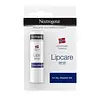What's inside
What's inside
 Key Ingredients
Key Ingredients

 Benefits
Benefits

 Concerns
Concerns

 Ingredients Side-by-side
Ingredients Side-by-side

Ricinus Communis Seed Oil
MaskingParaffin
PerfumingCera Alba
EmollientEthylhexyl Methoxycinnamate
UV AbsorberIsodecyl Neopentanoate
EmollientIsopropyl Myristate
EmollientCetyl Palmitate
EmollientCetearyl Alcohol
EmollientButyl Methoxydibenzoylmethane
UV AbsorberCetyl Alcohol
EmollientCera Microcristallina
Emulsion StabilisingVp/Eicosene Copolymer
Isohexadecane
EmollientBisabolol
MaskingPropylene Glycol
HumectantStearic Acid
CleansingPalmitic Acid
EmollientSodium Cetearyl Sulfate
CleansingCandelilla Cera
EmollientCitric Acid
BufferingDisodium Phosphate
BufferingPotassium Phosphate
BufferingBHT
AntioxidantParfum
MaskingCI 77891
Cosmetic ColorantRicinus Communis Seed Oil, Paraffin, Cera Alba, Ethylhexyl Methoxycinnamate, Isodecyl Neopentanoate, Isopropyl Myristate, Cetyl Palmitate, Cetearyl Alcohol, Butyl Methoxydibenzoylmethane, Cetyl Alcohol, Cera Microcristallina, Vp/Eicosene Copolymer, Isohexadecane, Bisabolol, Propylene Glycol, Stearic Acid, Palmitic Acid, Sodium Cetearyl Sulfate, Candelilla Cera, Citric Acid, Disodium Phosphate, Potassium Phosphate, BHT, Parfum, CI 77891
 Reviews
Reviews

Ingredients Explained
These ingredients are found in both products.
Ingredients higher up in an ingredient list are typically present in a larger amount.
Cera alba is beeswax, or the wax used by bees to make honeycombs. It is a texture-enhancer and emollient. A study from 2003 found beeswax to be a stronger emollient than ingredients such as petroleum jelly.
As an emollient, beeswax helps hydrate the skin by creating a barrier on top. This barrier traps moisture in.
Emulsifiers help prevent ingredients from separating. This helps create consistent texture.
The structure of beeswax is mainly long-chain alcohols and the esters of fatty acids.
There are three types of beeswax: yellow, white, and absolute. Yellow is pure beeswax taken from the honeycomb. White beeswax is created by filtering or bleaching yellow beeswax. Absolute beeswax is created by treating beeswax with alcohol. Beeswax used in cosmetics are purified.
Beeswax has been used throughout history and even in prehistoric times. Some common uses for beeswax still used today are making candles, as a waterproofing agent, and polish for leather.
Learn more about Cera AlbaCera Microcristallina isn't fungal acne safe.
Paraffin is a solid created from petroleum. The term 'paraffin' can also refer to either
petroleum jelly or mineral oil.
It has natural occlusive properties which can worsen oily skin. Due to its petrolatum base, this ingredient is not fungal-acne safe.
Parfum is a catch-all term for an ingredient or more that is used to give a scent to products.
Also called "fragrance", this ingredient can be a blend of hundreds of chemicals or plant oils. This means every product with "fragrance" or "parfum" in the ingredients list is a different mixture.
For instance, Habanolide is a proprietary trade name for a specific aroma chemical. When used as a fragrance ingredient in cosmetics, most aroma chemicals fall under the broad labeling category of “FRAGRANCE” or “PARFUM” according to EU and US regulations.
The term 'parfum' or 'fragrance' is not regulated in many countries. In many cases, it is up to the brand to define this term.
For instance, many brands choose to label themselves as "fragrance-free" because they are not using synthetic fragrances. However, their products may still contain ingredients such as essential oils that are considered a fragrance by INCI standards.
One example is Calendula flower extract. Calendula is an essential oil that still imparts a scent or 'fragrance'.
Depending on the blend, the ingredients in the mixture can cause allergies and sensitivities on the skin. Some ingredients that are known EU allergens include linalool and citronellol.
Parfum can also be used to mask or cover an unpleasant scent.
The bottom line is: not all fragrances/parfum/ingredients are created equally. If you are worried about fragrances, we recommend taking a closer look at an ingredient. And of course, we always recommend speaking with a professional.
Learn more about Parfum